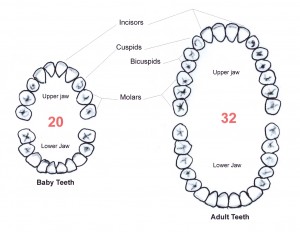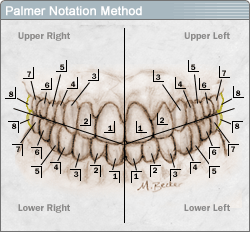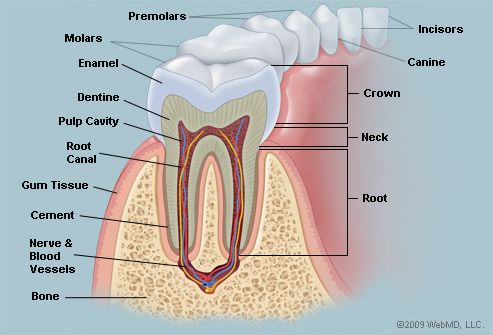Before we begin on focusing our attention to the effects of our environment and biological factors on our teeth and oral evolution, it is essential that we have some form of fundamental understanding of the anatomy and physiology of our teeth.
Adults have 32 permanent teeth with 16 on each jaw categorized into 4 categories: incisors, canines, molars, and premolar. Wisdom teeth are included in the 32 compromising a third set of molars. Children have their baby, teeth by the age of 2 with 20 tiny chompers, 10 on each jaw.Baby teeth are also referred to as milk teeth or scientifically as Deciduous teeth.
 |
| http://www.aschoonerofscience.com/science-at-home/baby-teeth-where-your-cheesy-grin-comes-from/ |
- 8 total
- Middlemost four teeth on on both upper and lower jaws
- 4 total
- Point teeth outside incisors
- 8 total
- Located behind the canines and molars
- 8 total
- Flat teeth in the rear of the mouth
- Includes third molars or Wisdom teeth (4 total)
 |
| http://www.funkyenglish.com/profiles/blogs/tooth-1 |
1. Upper (maxillary) right
2. Upper (maxillary) left
3. Lower (mandibular) right
4. Lower (mandibular) left
 |
| http://www.dentalfearcentral.org/resources/tooth-charts/ |
Parts of the Human Tooth
Human's bodies are a complex and constantly evolving organism, thus, it is no surprise human teeth share this similar characteristic. The physical structure and anatomy of a tooth represent the hardest substances in the human body utilized for multiple roles and a critical element in an individual's overall health.
 |
| http://www.webmd.com/oral-health/picture-of-the-teeth |
Dentin: underneath enamel made of living cells secreting calcium phosphate.
Pulp: soft, living structure inside tooth containing blood vessels and nerves.
Cementum: "cements" teeth into gums and jawbone
(Source)
Granted, the human tooth possess far more complex inner workings than a mere college student can learn on her own, but there will definitely be more structures that may be explored. For more information, view this PowerPoint.
That is a brief, but fairly conclusive overview of the anatomy and physiology of the human tooth. Up next, we will narrow our journey on understanding more of each type of tooth, including a focus on our milk, permanent, and wisdom teeth.
See you soon ya' big baboon!
 |
| http://www.you-can-be-funny.com/FunnyDentalCartoons.html |
It is really a great article no doubt! If you are thinking about dental discount plans MA, I can suggest you a trusted health savings leader- DentalSave- providing discount plans for 36 years and trusted by many people in Massachusetts state.
ReplyDelete